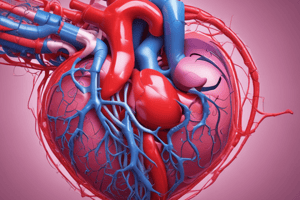Podcast
Questions and Answers
What are the two types of circulations involved in the human heart?
What are the two types of circulations involved in the human heart?
- Coronary and Peripheral
- Arterial and Venous
- Systemic and Pulmonary (correct)
- Atrial and Ventricular
What is the primary function of the A-V valves?
What is the primary function of the A-V valves?
- Allow bidirectional blood flow
- Pump blood against gravity
- Facilitate gas exchange
- Prevent backflow of blood (correct)
What is the role of the papillary muscles?
What is the role of the papillary muscles?
They attach to the cusps of the A-V valves via the chordae tendineae and help prevent backflow of blood.
Cardiac muscle only consists of contractile tissue.
Cardiac muscle only consists of contractile tissue.
What type of protein is titin?
What type of protein is titin?
What is the resting membrane potential (RMP) of cardiac muscle fibers?
What is the resting membrane potential (RMP) of cardiac muscle fibers?
The two functional syncytia in the heart are the two atria and the two ______.
The two functional syncytia in the heart are the two atria and the two ______.
Excitability is the ability of myocytes to remain inactive until stimulated.
Excitability is the ability of myocytes to remain inactive until stimulated.
What are gap junctions primarily responsible for?
What are gap junctions primarily responsible for?
Flashcards are hidden until you start studying
Study Notes
Circulations
- Systemic Circulation carries oxygenated blood from the left ventricle to the body organs through arteries, arterioles, capillaries, venules, veins, and ultimately to the right atrium.
- Pulmonary Circulation carries deoxygenated blood from the right ventricle to the lungs through pulmonary arteries, arterioles, capillaries, and ultimately returns oxygenated blood to the left atrium through pulmonary veins
Cardiac Valves
- Two atrioventricular (AV) valves (tricuspid and mitral) prevent backflow from the ventricles to the atria during diastole
- Papillary muscles are attached to the AV valves by chordae tendineae, which prevents the valves from inverting
- Two semilunar valves (aortic and pulmonary) prevent backflow from the aorta and pulmonary artery to the ventricles during systole.
Cardiac Muscle
- Cardiac muscle is composed of contractile tissue (98-99%) and excitatory-conductive system (1-2%)
- Contractile tissue contains contractile muscle proteins (actin, myosin, tropomyosin, and troponin)
- Excitatory-conductive system initiates and propagates electrical impulses throughout the heart, contains few contractile proteins, and is composed of the sinoatrial node (SAN), atrioventricular node (AVN), AV bundle (bundle of Hiss), right and left bundle branches, and Purkinje fibers.
- Titin is a large, elastic protein that binds myosin to the Z line, acts as a bidirectional spring, and provides structural support for the sarcomere.
- Dystrophin connects actin to the extracellular matrix (ECM), providing structural support to the myocyte, and defects in dystrophin can cause cardiac muscle weakness.
Cardiac Muscle Structure
- Cardiac muscle is striated in morphology (similar to skeletal muscle) but is involuntary like smooth muscle.
- Two functional syncytia: the two atria act as one syncytium, and the two ventricles act as another syncytium.
- Intercalated discs provide mechanical strength and electrical continuity between myocytes.
- Desmosomes provide intracellular connections between the cytoskeletons of adjacent cells.
- Gap junctions allow the spread of action potentials from one fiber to another, enabling cardiac muscle to function as a syncytium.
Cardiac Properties
- Excitability: the ability to respond to an adequate stimulus by generating a propagating action potential followed by contraction.
- Automaticity (Rhythmicity): the ability to initiate its own electrical impulse without external stimulation, allows for the regulated beating of the heart.
- Conductivity: the ability to propagate electrical impulses throughout the heart, ensures coordinated contraction of the heart chambers.
- Contractility: the ability to contract, enables the heart to pump blood throughout the body.
Excitability
- Resting Membrane Potential (RMP): the electrical potential difference between the inside and outside membrane surfaces during rest, typically -90 mV.
- Ionic basis of RMP: the unequal distribution of charged ions across the membrane, with more cations on the outside than the inside.
Studying That Suits You
Use AI to generate personalized quizzes and flashcards to suit your learning preferences.




